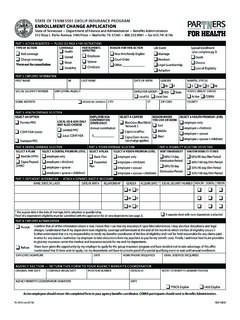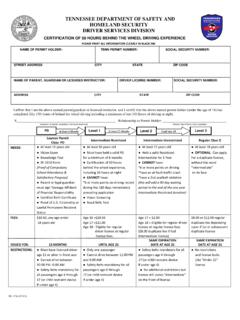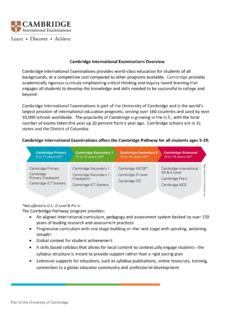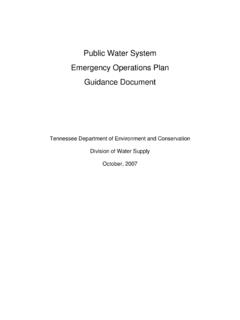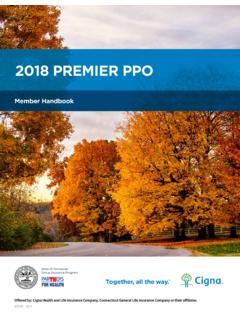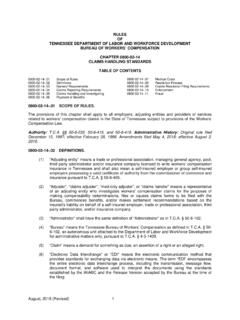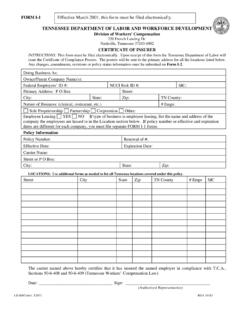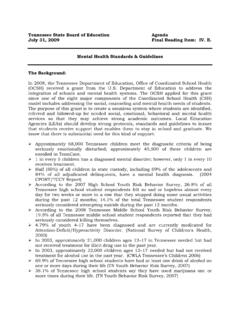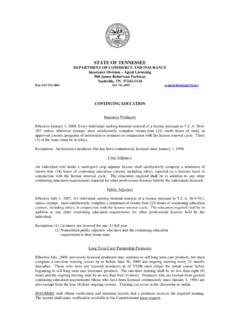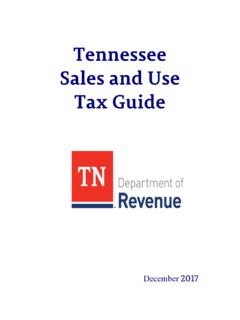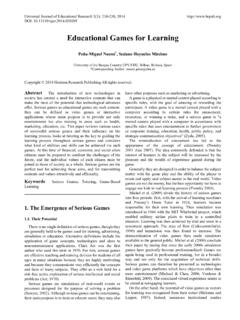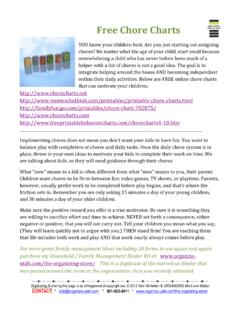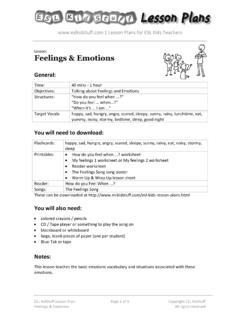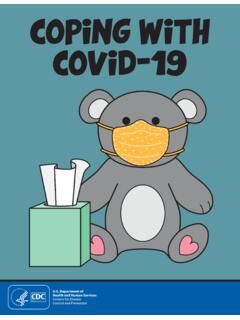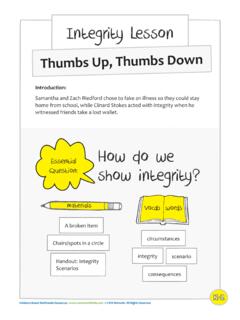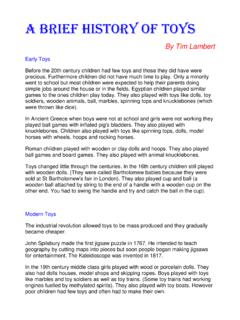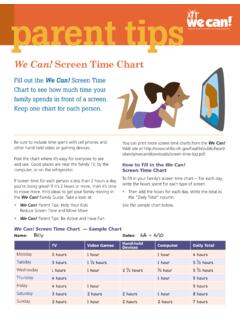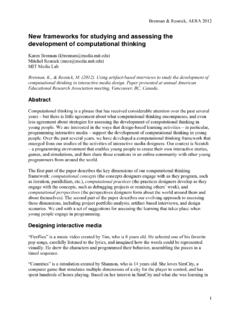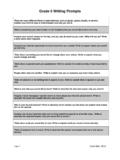Transcription of Keeping Kids Safe - Tennessee
1 Keeping kids safe Keeping kids safe Contents SECTION 1 GENERAL OVERVIEW AND INFORMATION. SECTION 2 PROTECTING CHILDREN. Parent Responsibilities Provider Responsibilities Community Responsibilities SECTION 3 PERSONAL SAFETY CURRICULUM. What is a Personal Safety Curriculum? SECTION 4 CHILD ABUSE AND NEGLECT. Definitions and Indicators Risk Factors Protective Factors Reporting Child Abuse and Neglect (Provider). SECTION 5 Keeping kids safe CURRICULUM. Teaching the Curriculum Frequently Asked Questions Keeping kids safe Curriculum Teaching Aids SECTION 6 PARTNERING WITH PARENTS. What Is a Personal Safety Curriculum? Reporting Abuse and Neglect Parent Overview Letter for Each Unit SECTION 7 PARENT MEETING GUIDE. SECTION 8 RESOURCES. Character Pictures 1. Keeping kids safe Section 1. Introduction and Overview All material in this section is a compilation of information from the following sources with details listed in the References section: 2005 Community Resource Packet, safe Children and Healthy Families Area a Shared Responsibility; 2005 Protecting Children from Sexual Abuse; Caregivers of Young Children: Preventing and Responding to Child Maltreatment User Manual Series.
2 Prevention of Child Abuse in Early Childhood Programs and Responsibilities of Early Childhood Professionals to Prevent Child Abuse; Understanding Child Maltreatment: An Introduction to Definitions, Incidence, and Risk/Protective Factors; Protecting Children from Sexual Abuse in the Community, A Guide for Parents and Caregivers; In Loving Hands kids Blossom. 2. Keeping kids safe Introduction and Overview The Problem of Child Abuse The impact of child abuse and neglect is far greater than its immediate visible effects. These experiences can shape child development and have consequences that last years, even lifetimes. Research now shows that the physical, psychological, and behavioral consequences of child abuse and neglect impact not just the child and family, but the community as a whole. Child abuse and neglect can be devastating for children and their families. Numerous research studies have consistently documented a range of negative health, emotional and psychological outcomes for children who have experienced child maltreatment.
3 The immediate physical effects of abuse can range from relatively minor, such as a bruise or cut, to severe, such as broken bones, internal bleeding or even death. The immediate psychological effects of abuse and neglect isolation, fear, and lack of trust- can spiral into long term mental health consequences including depression and anxiety, low self-esteem, difficulty establishing and maintaining relationships, eating disorders and suicide attempts. Studies have found abused or neglected children to be at least 25 percent more likely to experience problems in adolescence, including delinquency, teen pregnancy, drug use and low academic achievement. As adults, children who experienced abuse or neglect have an increased likelihood of criminal behavior, involvement in violent crime, abuse of alcohol and other drugs and abusive behavior. 3. Keeping kids safe Section 2. Protecting Children All material in this section is a compilation of information from the following sources with details listed in the References section: 2005 Community Resource Packet, safe Children and Healthy Families Area a Shared Responsibility; 2005 Protecting Children from Sexual Abuse; Caregivers of Young Children: Preventing and Responding to Child Maltreatment User Manual Series.
4 Prevention of Child Abuse in Early Childhood Programs and Responsibilities of Early Childhood Professionals to Prevent Child Abuse; Understanding Child Maltreatment: An Introduction to Definitions, Incidence, and Risk/Protective Factors; Protecting Children from Sexual Abuse in the Community, A Guide for Parents and Caregivers; In Loving Hands kids Blossom. 4. Keeping kids safe Protecting Children Parent Responsibilities Help Your Children Feel Loved and Secure A healthy, nurturing relationship with your child is built through countless interactions over the course of time. It requires a lot of energy and work, but the rewards are well worth it. Steps to strengthen a parent's relationships with their children include: Make sure your child knows you love them, even when they do something wrong. Encourage your children. Praise their achievements and talents. Recognize the skills they are developing. Spend time with your children. Do things together that you both enjoy.
5 Listen to your child. Learn how to use nonphysical options for discipline. Many alternatives exist. Depending on your child's age and level of development, these may include simply redirecting your child's attention, offering choices, or using time out.. Make Sure Your Children are Well Cared For To take good care of your children, be sure they: Eat nutritious foods. Try to make mealtime fun. Regular meal times help you to be sure your children are getting the right nutrition at the right time. Receive good medical care. Care begins before babies are born. After birth, regular medical visits allow your children's doctor to monitor their development, immunize them against various diseases, and address any questions, concerns, or frustrations you have about your children's health or behavior. Develop good sleep habits. Happy, healthy children need regular sleep. Having a bedtime routine helps children settle down and prepare for sleep. Are kept safe .
6 Infants should never be out of a parent or caretaker's sight unless they are in a crib or another equally safe place. As soon as children begin to crawl, it is important to childproof your home. Toddlers need supervision and frequent reminders about behaviors that are dangerous. Choose caregivers carefully to be sure your children are safe , even when you can't be with them. 5. Keeping kids safe Make Communicating with Your Child a Priority Below are some communication tips for parents to follow. The tips build upon parent's existing good parenting skills and knowledge of their own children. Make time for your children. Build an open and trusting relationship with your children. Always listen carefully to their fears and concerns and let them know they should not be worried about telling you anything. This is just as important when children are adolescents. Know where your children are, who they are with, and agree upon a time when they should return.
7 Make sure your children know where you are at all times and where you can be contacted. Be alert to any adult who is paying an unusual amount of attention to your children such as buying them candy, expensive gifts, video or computer games , etc. Be cautious about anyone who has unsupervised contact with your children and find out as much as possible about anyone who is looking after them. Children need to know what is and what is not appropriate touching. Do not be too embarrassed to talk about this. You must help them understand what is unacceptable behavior and that they must always tell you if anyone, including a relative or friend, is behaving in a way that worries them. Explain the difference between good and bad secrets in the family. Tell your child it is OK to have a secret about something like a surprise birthday, but not about anything which makes them feel unhappy or uncomfortable. Help with sex education. If you feel uncomfortable teaching a child correct names for body parts or answering questions young children ask about sex, your doctor or nurse should be happy to advise you.
8 Most important of all, teach your child that they have the right to refuse to do anything with an adult which they feel is wrong or which frightens them. Stress that they should not hesitate to tell you or another adult if something happens that they don't like. Despite what many people think, most abuse of children (including sexual abuse) is carried out by someone they know, including relatives and family friends. This can make it a very difficult problem to face. Often parents find the idea of abuse so shocking that at first they refuse to believe it could happen in their family. 6. Keeping kids safe Child sexual abuse can happen in all areas of society and can come from any professional, racial or religious background. Sexual abusers may sometimes hold influential positions outside their families and so may appear to be well-respected members of society. Those who abuse children in families include fathers, stepfathers, live-in partners, boyfriends, brothers, uncles, male cousins, grandfathers and father figures.
9 In a small number of cases the abuser may be the mother or female relative. Adults who present themselves as family friends may also abuse children. Adults who abuse members of their own families may also abuse children in other families they know. Contrary to the popular image, child sex abusers often appear kind, concerned and caring towards children. But this is part of deliberately building close relationships with children, to allow them to abuse without being suspected or discovered. They may also convince themselves that they are doing no harm to the child. If a family member sexually abused you as a child or as an adult, you should do everything you can to protect your child from that family member or friend. Your children must be your first priority, however painful the consequences may be for you. The abuser's behavior is unlikely to stop unless you take action to protect your child and the abuser receives help. 7. Keeping kids safe Protecting Children Provider Responsibilities As the child's teacher and caregiver, you play a partnership role with the child's family in ensuring the healthy development and safety of each child in your agency.
10 You have the primary responsibility to make sure that no child is abused or neglected in any way while in your care. In addition, you can play a significant part in teaching children to value themselves and to learn, as they develop, to care for and protect themselves. Sexual abuse can have very damaging effects on a child, which can last into adulthood. However, for many children the effects will be relatively short-term, depending on the individual child, the nature of the abuse and the help they receive. Such abuse can continue for years, and sometimes into adulthood. Children often have very confused feelings about being abused by someone they trust to protect them. They may not always realize that what is being done to them is abuse. 8. Keeping kids safe Protecting Children Community Responsibility Because children are victimized in every part of the country, each community needs to provide an educational program that better ensures the safety of the children in its area.
